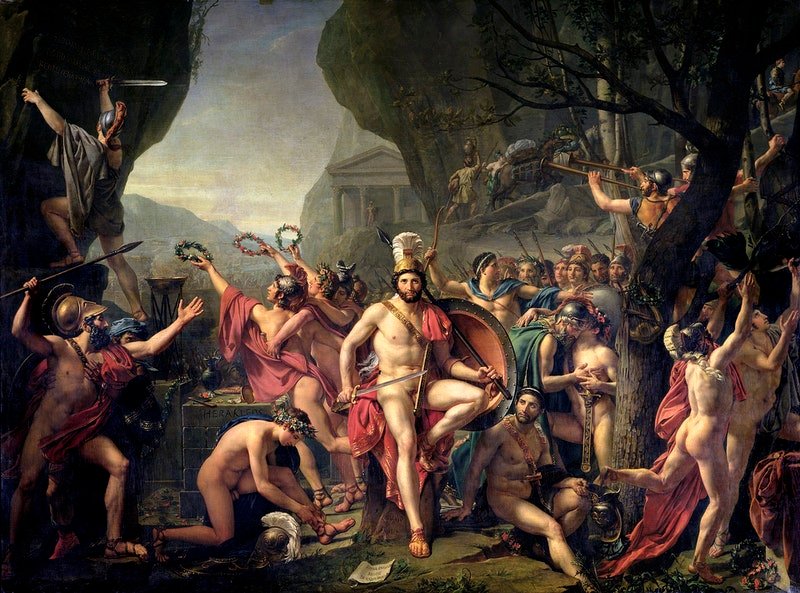The Spartan Agoge: Investigation of Badassery
Have you ever seen the movie 300? Whether you enjoy chest and bicep day or not, trying to ignore physical greatness is seemingly an impossible concept. When Gerard Butler kicks some politically misinformed gent off a cliff, wearing the occasional Spartan-Velvet cape, a speedo, boots, and a sword hanging at his side – Did you notice the next level shreddedness of his body? What about that horde of “other” partially nude combatants? Right. . ., the “warrior” physique is unmistakable: from V-taping backs, ridiculously outlined 6-packs, and barrel-chested beard breathing monster aesthetics, the Spartan physique, is no joke, and as history tells us – it is very much real. Let’s dive into the outrageously cool culture of Sparta and learn a thing or two about the ‘Agoge.’
How Accurate Are the Movies?
According to the ancient Greek historian Plutarch, in Sparta, specifically selected male citizens would undergo a rigorous training and educational process from a very early age. Shortly after birth, elders would evaluate the boys. The children would be allowed to live were most “well built and sturdy.” Those who were deemed unfit were “left at the foot of a mountain to die.” At the preposterously absurd age of seven, Spartan boys are assigned to a specific company with which they would live, study, and train together with. Adults would choose a captain for the company at that same age. That captain (selected by bravery) would instill militaristic obedience and leadership to the rest of his unit.
Academically, there is much debate as to what emphasis Spartans placed on education. Some scholars, such as Professor Emeritus at the University of Nottingham, “says there are hints in other sources that they received standard Greek elementary education in reading, writing, numbers, song, and dance.” There are historical recordings which state how these children are taught from birth to rely on minimalistic principles: often going barefoot and refusing to bathe, which made the skin hard and dry. They made their beds from plants and had nothing but a cloak so that they could learn how to adapt.
Of course, as cinematography has made it so very clear, Spartans maintained a lean athletic frame at all times. In Donald G. Kyle’s book. Sport and Spectacle in the Ancient World, the author mentions how the historian, Plutarch, had written numerous accounts of which foretold how young Spartans would present themselves to the public in full nudity quite often, and that if they did not appear sufficiently fit, then they would be flogged and whipped. The competitive nature of Spartan childhood was nothing short of extreme. Kyle mentions several other findings: how the Spartans would race one another and compete in wrestling. He also tells how two teams “would try to drive each other off an island by pushing, kicking, biting and gouging their opponents.”
Xenophon, a historian who lived from late 400 to 300 BC, wrote of Spartan dietary practice. The idea behind being given limited nutrition, besides the focus of maintaining an aesthetic figure, was to embolden the youth to go out and steal food from others “in order to make the boys more resourceful in getting supplies, and better [at] fighting men.” In addition, Xenophon includes how if and when Spartans would be caught stealing, they were then punished, thus another focus of this practice was to teach these children how to steal and not get caught in the process. Beliefs such as these went even further. Xenophon and Plutarch both share similar writings which tell a story of how there was an annual ritual. Spartan youth try and steal cheese from a temple altar, and then they would try to evade the lashes of armed guards with swinging whips. Courage, Stoicism, and Fortitude… these conceptual notions would become indistinguishable with the hero-like troopers.
Agoge…or Lifestyle?
Paul Cartledge, a professor of Greek culture at the University of Cambridge, wrote that The Agoge, “was a trial by ordeal.” Not only was this an instrumental basis of Spartan culture, but it would allow the soldiers to one day become welcomed within communal dining, it allowed access to higher levels of society, and obviously so – it led to the “becoming of a full-fledged Spartan citizen and soldier.” Real military training would not become present in a Spartan’s lifetime until much later into adulthood. The Agoge, its real focus was to ensure that these children would become compliant within the famed society of Sparta. This system would create a handful of people who were ready to lie down and die for one’s nation. Today we know Sparta for its unmeasured level of socio-political stability, unlike other Greek city-states. This was partly due to the fact that the Agoge enforced a lifestyle that required harmonious cooperation between one another.
This bewildering array of methodology that was used through the Agogeical process, was not the primary reason for their success in battle. The opponent was faster, more endurable, stronger, and more mentally prepared than, but it was not the only card that Spartans held up their sleeves. The real spartan superpower was not indifference to suffering or some unattainable level of physical fitness, “but rather [it] [was] superior organization.” They would execute militaristic strategies until achieving perfection. Xenophon’s writings suggest that Spartan soldiers were able to maneuver in unison with flawless grace. On the battlefield, no one could match their tactics. According to Plutarch, throughout a Spartan’s lifetime, they were never without some form of prescribed regimen, and at seemingly all times, Spartans would continue military training to what seemed like forever.
This system of culture required boys to not accept manhood and would be guided upon a path that would allow them to earn it themselves. The Agoge means “a leading,” and this system would train Spartans to become “Homoioi,” an elite warrior class. The Spartan Agoge “was one long rite of passage that transitioned a young Spartan male from childhood to puberty to youth, and finally into manhood, while passages progressed him from one age to the next.” At all times throughout this process, one of martial, religious, physical and moral implication – the assertions of one’s loyalty to Sparta and the values of one’s culture would be heavily reinforced. This way of life for the famed representatives of Sparta would go on to establish one of the most badass fighting forces the world has ever seen.
WHAT’S NEXT?
When attempting to create a Spartan-Agoge-Style training atmosphere it is important to acknowledge that we can not simply know for sure how a Spartan would spend his day inside a weight room, or if he would use one at all in the first place. However, because we do understand of what principles existed within the Agoge, such as strength, speed, mobility, conditioning and discipline; we can theoretically create a training regimen based on belief alone. The idea is to emphasize bodyweight-oriented metabolic conditioning behind this workout – this is a body-style beatdown.
Here is the Spartan-Inspired Agoge Blitz!
- Goals
-
-
- Reduce Bodyfat Composition (They Held Strongly To The Lean & Mean Motto)
- Increase Cardiovascular Performance (Conditioning For Battle Is A No-Brainer)
- Increase Strength (Carrying A Sword And Shield All Day Is Not So Easy)
- Body Control (Operating At An Elite Level Required Functional Adjustment)
- Discipline Express (Organization and Dedication Are A Must For Badassery)
-
- The Agoge Blitz W.O.D.
- 1 Mile Run
- 50 Sit-Ups
- 10 Explosive Plyometric Push-Ups (Clapping Push Ups)
- 20 Deep Squat to Tuck Jumps
- 10 Pull-Ups (Chair-Assisted Chin Ups if Unable)
- 5 Muscle Ups (10 More Pull-Ups if Unable)
- 15 Handstand Pushups (20 Close-Grip Pushups if Unable)
- 20 Deep Squat to Tuck Jumps
- 40 Bicycle Crunches
- 20 Close-Grip Pushups
- 1 Minute Plank Hold
- 10 Burpees
- Rest for 2-4 Minutes Max
- Repeat X 3 CIRCUITS!!
https://www.history.com/news/sparta-warriors-training AUTHOR PATRICK J. KIGER
https://www.artofmanliness.com/articles/the-spartan-way-manhood-is-a-journey/ AUTHOR BRETT AND KATE MCKAY

Caleb Giachelli, a level 192 Altmerian-High-Elf warrior in the world of Skyrim, is usually super setting chest and biceps and sometimes can be found snapkicking...



